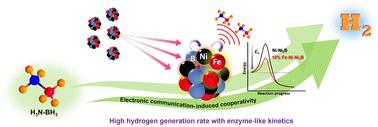当前位置:
X-MOL 学术
›
J. Mater. Chem. A
›
论文详情
Our official English website, www.x-mol.net, welcomes your
feedback! (Note: you will need to create a separate account there.)
Fe hotspots in the Ni–Ni3B nanocatalyst unravel remarkable cooperativity to boost hydrogen production from ammonia borane with enzyme-like catalysis
Journal of Materials Chemistry A ( IF 10.7 ) Pub Date : 2022-11-15 , DOI: 10.1039/d2ta05465e Rajani Kumar Borah 1, 2 , Adarsh P. Fatrekar 1, 2 , Pratibha Bakre 3 , Santosh G. Tilve 3 , Amit A. Vernekar 1, 2
Journal of Materials Chemistry A ( IF 10.7 ) Pub Date : 2022-11-15 , DOI: 10.1039/d2ta05465e Rajani Kumar Borah 1, 2 , Adarsh P. Fatrekar 1, 2 , Pratibha Bakre 3 , Santosh G. Tilve 3 , Amit A. Vernekar 1, 2
Affiliation

|
Cooperative catalysis is a well-known phenomenon exhibited by some enzymes wherein multiple entities function in tandem to catalyze reactions efficiently and/or with selectivity. However, designing advanced heterogeneous catalysts that can cooperatively regulate reactions is exciting, but it is a challenging task. Herein, the fractional incorporation of Fe like hotspots in the Ni–Ni3B nano-matrices (10% Fe–Ni–Ni3B) furnishing remarkable cooperativity that can finely regulate the hydrogen production from the chemical hydrogen storage material, ammonia borane (AB), under ambient conditions is unveiled. Experimental evidence and dehydrogenation kinetic studies reveal that Fe acts as an activator by inducing strong electronic communication in the catalyst matrix. These interactions boost the H2 generation rate to ∼8500 mL min−1 gcatalyst−1 and significantly reduce the activation energy (Ea) to 39.95 kJ mol−1 from 55.14 kJ mol−1 calculated for Ni–Ni3B alone. The Fe-incorporated catalyst shifts the half-order dehydrogenation kinetics of Ni–Ni3B to Michaelis Menten-like kinetics, typically observed for enzymes, showing a rate max (Rmax) ∼18 000 mL min−1 gcatalyst−1. Heterogeneous catalysts rarely exhibit such a cooperative property and enzyme-like catalysis for a non-enzymatic reaction. The catalyst shows 100% H2 generation efficiency and a high turnover frequency (TOF) of ∼293 molH2 molFe−1 min−1. Upon interaction of dopamine with the Fe active centers, the electronic communications attenuate, diminishing the dehydrogenation rate, and confirming that electronic communication is necessary for cooperative catalysis. This investigation highlights the engineering of materials to induce electronic interactions and cooperativity, which may spur interest in developing inexpensive catalysts for meeting the energy demand.
中文翻译:

Ni-Ni3B 纳米催化剂中的 Fe 热点揭示了显着的协同作用,可通过类酶催化促进氨硼烷产氢
协同催化是一些酶表现出的一种众所周知的现象,其中多个实体串联起作用以有效地和/或具有选择性地催化反应。然而,设计能够协同调节反应的先进多相催化剂令人兴奋,但却是一项具有挑战性的任务。在此,在 Ni-Ni 3 B 纳米基体(10% Fe-Ni-Ni 3B) 提供显着的协同作用,可以在环境条件下精细调节化学储氢材料氨硼烷 (AB) 的氢气生产。实验证据和脱氢动力学研究表明,Fe 通过在催化剂基质中诱导强电子通讯而充当活化剂。这些相互作用将 H 2生成速率提高到 ~8500 mL min -1 g催化剂-1,并显着降低活化能 ( E a ),从 55.14 kJ mol -1单独计算的 Ni-Ni 3 B降至 39.95 kJ mol -1 。掺铁催化剂改变了 Ni-Ni 的半级脱氢动力学3 B 到 Michaelis Menten 样动力学,通常观察到酶,显示最大速率 ( R max ) ∼18 000 mL min -1 g催化剂-1。对于非酶促反应,多相催化剂很少表现出这种协同性质和类似酶的催化作用。该催化剂显示出 100% 的 H 2生成效率和高周转频率 (TOF) ~293 mol H 2 mol Fe -1 min -1. 在多巴胺与 Fe 活性中心相互作用后,电子通信减弱,降低了脱氢速率,并证实电子通信对于协同催化是必要的。这项研究强调了材料工程以诱导电子相互作用和协同性,这可能会激发人们对开发廉价催化剂以满足能源需求的兴趣。
更新日期:2022-11-15
中文翻译:

Ni-Ni3B 纳米催化剂中的 Fe 热点揭示了显着的协同作用,可通过类酶催化促进氨硼烷产氢
协同催化是一些酶表现出的一种众所周知的现象,其中多个实体串联起作用以有效地和/或具有选择性地催化反应。然而,设计能够协同调节反应的先进多相催化剂令人兴奋,但却是一项具有挑战性的任务。在此,在 Ni-Ni 3 B 纳米基体(10% Fe-Ni-Ni 3B) 提供显着的协同作用,可以在环境条件下精细调节化学储氢材料氨硼烷 (AB) 的氢气生产。实验证据和脱氢动力学研究表明,Fe 通过在催化剂基质中诱导强电子通讯而充当活化剂。这些相互作用将 H 2生成速率提高到 ~8500 mL min -1 g催化剂-1,并显着降低活化能 ( E a ),从 55.14 kJ mol -1单独计算的 Ni-Ni 3 B降至 39.95 kJ mol -1 。掺铁催化剂改变了 Ni-Ni 的半级脱氢动力学3 B 到 Michaelis Menten 样动力学,通常观察到酶,显示最大速率 ( R max ) ∼18 000 mL min -1 g催化剂-1。对于非酶促反应,多相催化剂很少表现出这种协同性质和类似酶的催化作用。该催化剂显示出 100% 的 H 2生成效率和高周转频率 (TOF) ~293 mol H 2 mol Fe -1 min -1. 在多巴胺与 Fe 活性中心相互作用后,电子通信减弱,降低了脱氢速率,并证实电子通信对于协同催化是必要的。这项研究强调了材料工程以诱导电子相互作用和协同性,这可能会激发人们对开发廉价催化剂以满足能源需求的兴趣。











































 京公网安备 11010802027423号
京公网安备 11010802027423号